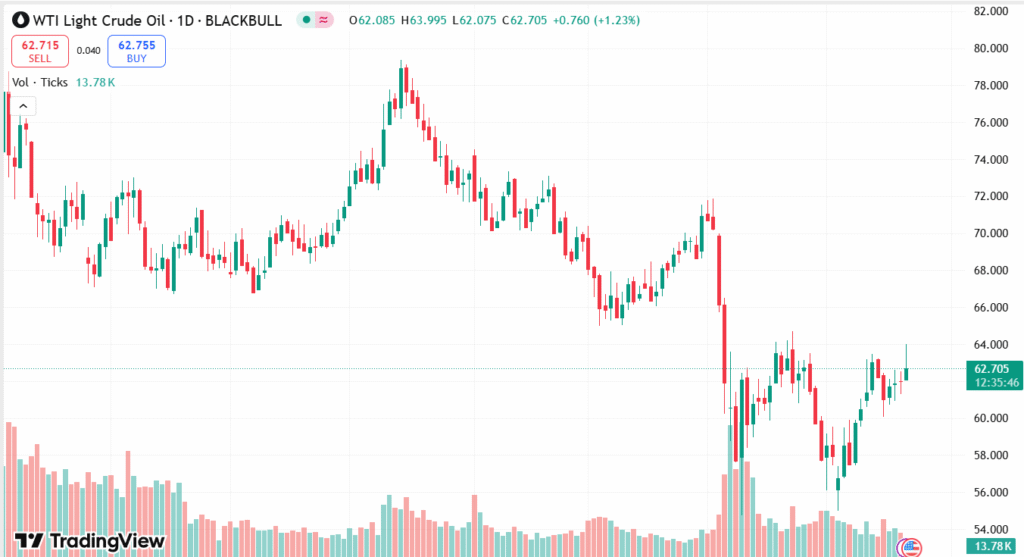Prices for West Texas Intermediate crude oil have risen past $62.50 a barrel, up for the fourth straight session, as tensions in the Middle East rise and supply worries build. The spike comes amid reports that Israel is considering possible attacks on Iranian nuclear sites, causing concern about retaliatory attacks that will interrupt oil shipments through the key Strait of Hormuz—a conduit for exports from top Gulf producers. Although the increased supply anxiety mounts, the benefit may be clipped by a surprise increase in U.S. crude inventories, with the API saying it rose 2.49 million barrels, defying expectations of a draw. In addition, Kazakhstan’s surprise increase in oil output puts additional pressure on global supply dynamics leading up to the release of the EIA’s inventory data.
KEY LOOKOUTS
• Markets are waiting anxiously for confirmation or intensification of Israeli intentions to attack Iranian nuclear facilities and interrupt oil supply routes and global stability considerably.
• Any Iranian retaliation that leads to a blockade or disruption in the Strait of Hormuz could severely impact crude oil exports from key producers like Saudi Arabia, Kuwait, Iraq, and the UAE.
• Investors await the upcoming EIA Crude Oil Stocks Change report, which could either reinforce or offset current bullish momentum depending on whether it confirms the API’s unexpected inventory build.
• Kazakhstan’s rise in oil production, in defiance of OPEC+ pressure to cut supply, could impact wider debate within the alliance and influence the direction of future oil prices.

Geopolitical tensions in the Middle East continue to keep oil markets anxious as Israel is said to be preparing to attack Iranian nuclear sites—spurring concerns of possible retaliation and disruption of crude flows through the critical Strait of Hormuz. This has propelled WTI above $62.50 on increased supply worries from major Gulf producers. The rally, however, may be threatened by a surprise U.S. crude build of 2.49 million barrels according to API data ahead of the closely followed EIA report. Further complications are introduced by Kazakhstan’s surprise 2% rise in oil output, even amidst OPEC+ production restrictions.
WTI crude prices have jumped higher than $62.50 as tensions escalate in the Middle East with news of possible Israeli attacks on Iranian nuclear facilities. Supply fears are compounded by concerns of disruption via the Strait of Hormuz, but gains will be capped by a shocking build in U.S. crude stockpiles and increased output from Kazakhstan.
• WTI crude prices increased past $62.50, the fourth straight session of gains in wake of geopolitical tensions.
• Israel could attack Iranian nuclear facilities, raising the threat of regional conflict and supply disruption, according to reports.
• Any retaliation from Iran could close the Strait of Hormuz, a vital artery for global oil supplies from top Gulf producers.
• API data indicated a 2.49 million-barrel build in U.S. crude inventories, against a forecasted 1.85 million-barrel draw.
• The surprise U.S. inventory increase could put the lid on further price rises, signifying strongening supply in the world’s biggest oil consumer.
• Kazakhstan boosted oil output by 2% last month, in defiance of OPEC+ pressure to restrain production, adding to global supply fears.
• Market participants wait for EIA stock details for further guidance, which may validate or defy API numbers and sway market mood.
Middle East tensions have intensified with the news that Israel is weighing attacks on Iranian nuclear sites. This has generated serious concerns over possible oil supply disruptions, especially if Iran responds by closing the Strait of Hormuz — a vital shipping route for world crude shipments. The situation attracted international attention, as any war between key oil-producing countries in the region has the potential to affect the balance of energy markets and global relations.
WTI CRUDE OIL DAILY PRICE CHART

CHART SOURCE: TradingView
Meanwhile, events beyond the Middle East are also defining the international oil outlook. The United States recorded a greater-than-anticipated build-up of its crude oil stocks, indicating an uptick in local supply. Meanwhile, Kazakhstan increased its oil output by 2% in May, above its quota limits as part of the OPEC+ accord. These are a mirror of the continued complexity of the international energy environment, where political risk and production choices from major producers keep impacting the overall landscape.
TECHNICAL ANALYSIS
WTI crude oil is maintaining steady bullish traction, trading above the $62.50 support zone and edging near $62.70 during early European trading. The price has furthered advances for a fourth consecutive session, reflecting robust short-term buying demand. If the bullish trend continues, the next resistance could be found around the zone of $63.50–$64.00. On the downside, immediate support lies near $62.00, supported by a stronger support level at $61.20. The momentum indicators, such as RSI, approach overbought territory, which may likely lead to a consolidation or pullback in the short term unless fresh drivers are seen for further gains.

FORECAST
WTI crude can extend its rally if geopolitical tensions in the Middle East intensify even more, especially if Israel goes ahead with a military strike against Iran or Iran attempts to close the Strait of Hormuz. Such an event would increase concerns over supply disruption from major Gulf producers, lifting prices. Further bullish pressure may arise if the next EIA report reveals a surprise U.S. crude inventory draw or if OPEC+ producers cut supply in reaction to market turbulence. If the bullish trend continues, WTI may test resistance values between $63.50 to $65.00 in the near future.
However, crude oil prices could face downward pressure if geopolitical tensions ease or if it becomes clear that Israel has not made a final decision on military action. A further build in U.S. crude inventories, as signaled by recent API data, may also weigh on market sentiment, indicating stronger supply levels. Additionally, rising output from non-OPEC producers like Kazakhstan, and potential demand concerns, could contribute to a pullback. If the bearish strength intensifies, WTI can go down to support levels around $62.00 or even $61.20.







